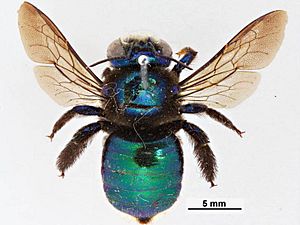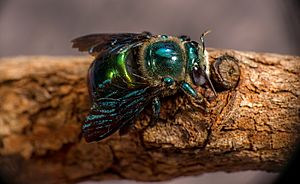Peacock carpenter bee facts for kids
Quick facts for kids Peacock carpenter bee |
|
|---|---|
 |
|
| Female | |
| Scientific classification | |
| Genus: |
Xylocopa
|
| Species: |
bombylans
|
The peacock carpenter bee (scientific name: Xylocopa bombylans) is a type of carpenter bee. You can find these cool bees in Australia. They are called "carpenter bees" because they dig into wood to make their homes.
A scientist named Johan Christian Fabricius first described this bee in 1775. Its scientific name, bombylans, means "like a bumblebee" in Latin. The word "Xylocopa" comes from Ancient Greek and means "wood-cutter."
Contents
About the Peacock Carpenter Bee
What Does It Look Like?
The peacock carpenter bee has a shiny, metallic blue-green or green color. Sometimes, it might even look a bit purple. It is a large and strong bee. When it flies, you can often hear a loud, low buzzing sound.
Male peacock carpenter bees have white markings on their faces. These bees can sting, and it might hurt, but no serious stings have been reported.
Where Do They Live?
These bees live in eastern Australia. You can find them from the Cape York Peninsula in northern Queensland. They live all the way south to the Sydney area. In Sydney, they sometimes live near another type of carpenter bee called the golden-green carpenter bee.
You can see peacock carpenter bees from spring to autumn. They often visit flowers from the pea family, called Fabaceae. This includes plants like Gompholobium species. They also like Gompholobium latifolium in spring. In autumn, they visit Pultenaea elliptica.
The peacock carpenter bee helps pollinate a plant called Melastoma affine. They also visit many other flowers. These include Banksia, Xanthorrhoea, Hardenbergia violacea, Tristania, Leptospermum, Aotus, Cassia, and Leucopogon.
How Do They Build Nests?
Peacock carpenter bees make their nests by digging into soft wood. They use stalks of grasstrees (Xanthorrhoea). They also use soft wood from trees like Banksia, Casuarina, Melaleuca, and Leptospermum.
The female bee digs a tunnel using her strong jaws. She pushes the wood shavings outside the tunnel. These tunnels can be about 30 centimeters (12 inches) long. They are usually 11 to 14 millimeters (0.4 to 0.5 inches) wide.
If the wood is big enough, several tunnels can be made. Sometimes, more than one female bee will use a nest. One female will lay eggs, and others will guard the nest. A bee protects the nest entrance, which is about 7 to 10 millimeters (0.3 to 0.4 inches) wide. It blocks the entrance with its body.
Both male and female bees can stay in the tunnels during winter. The tunnels are divided into small rooms called cells. In each cell, the mother bee lays an egg. She also leaves a supply of nectar and pollen for the young bee to eat.


